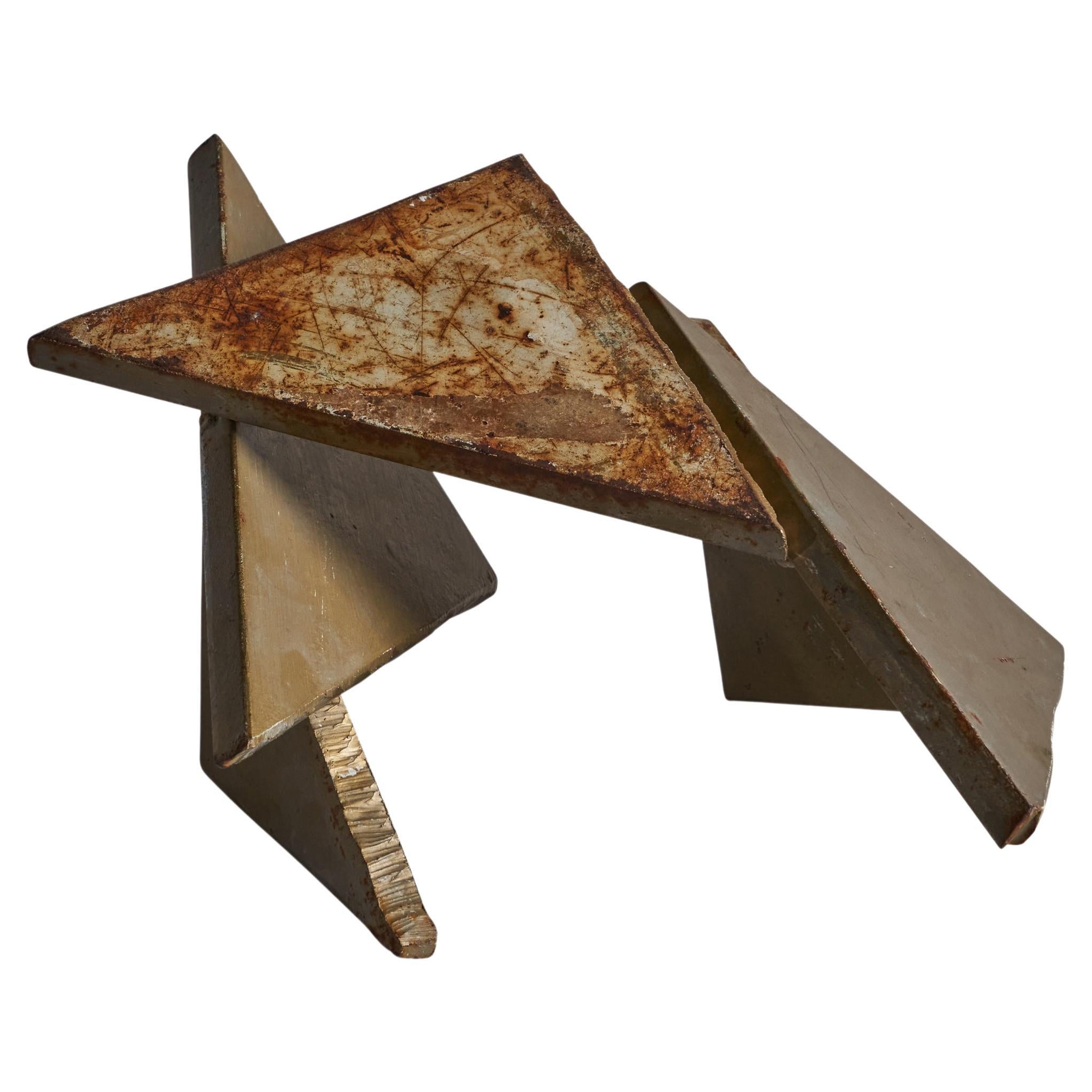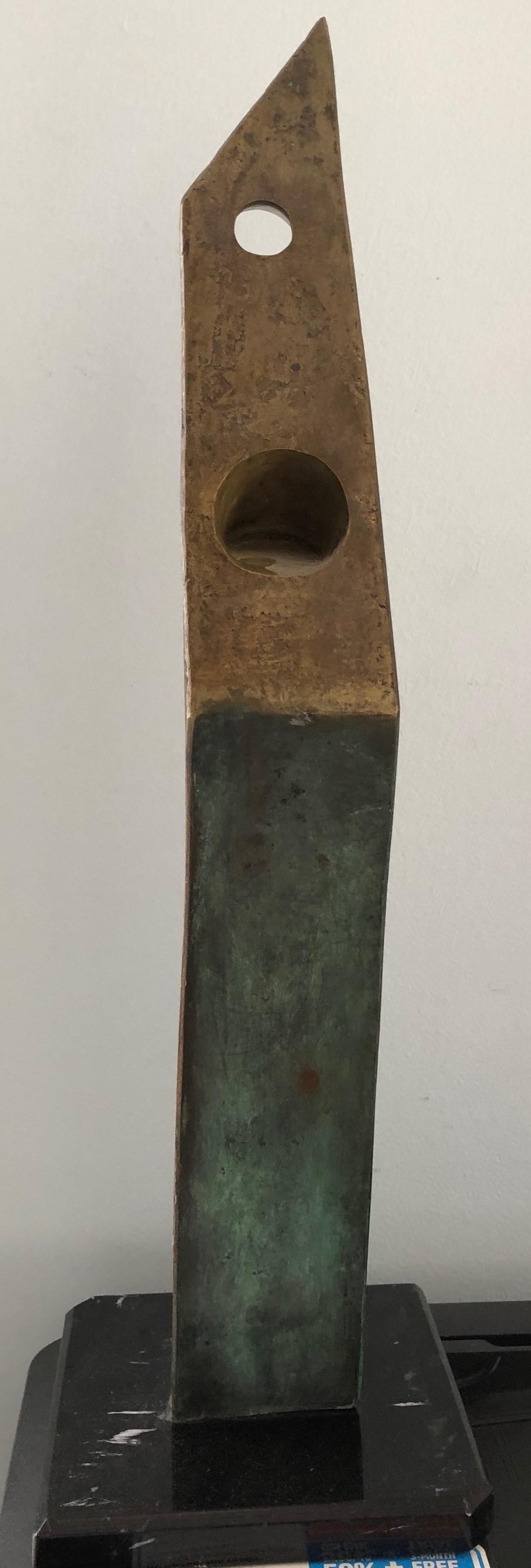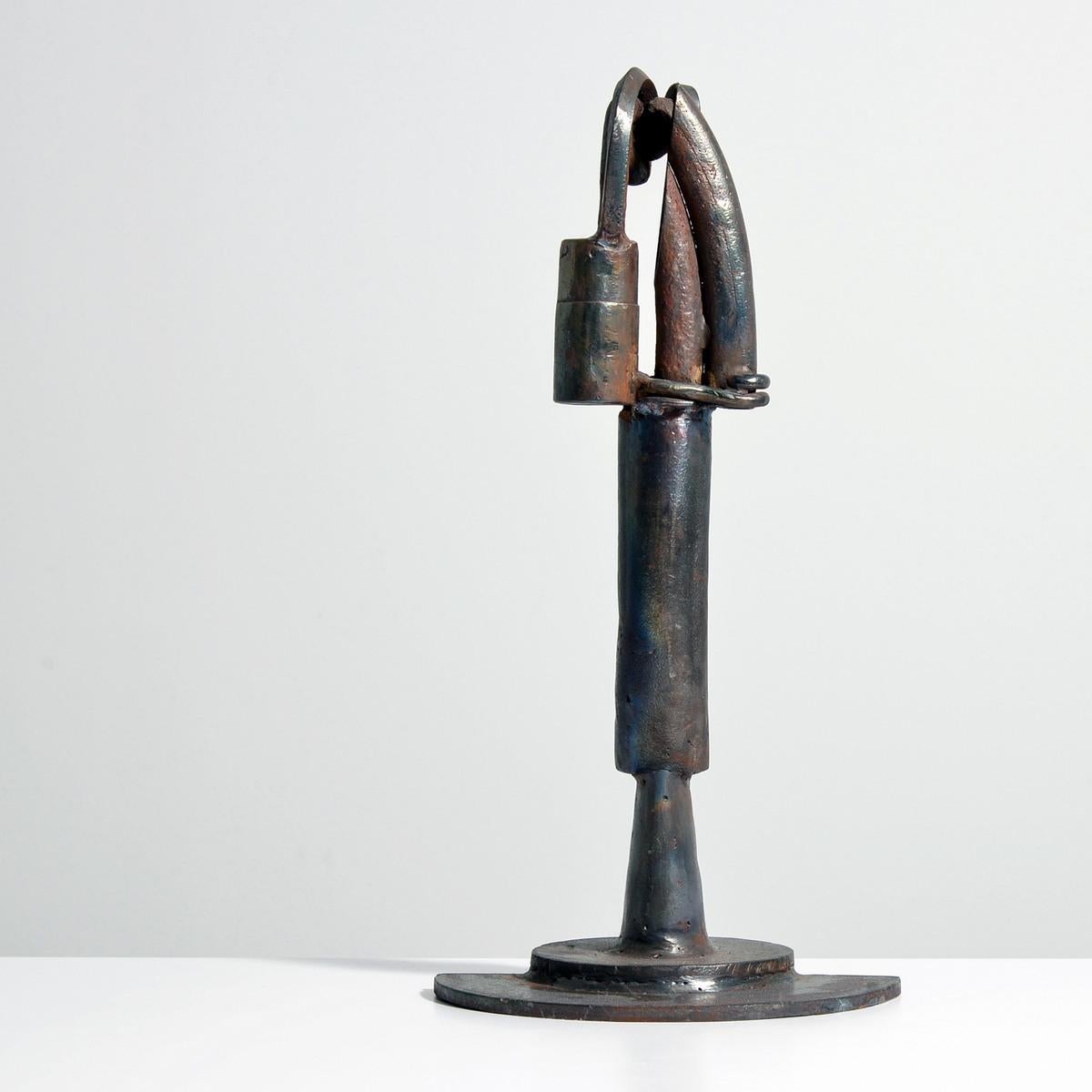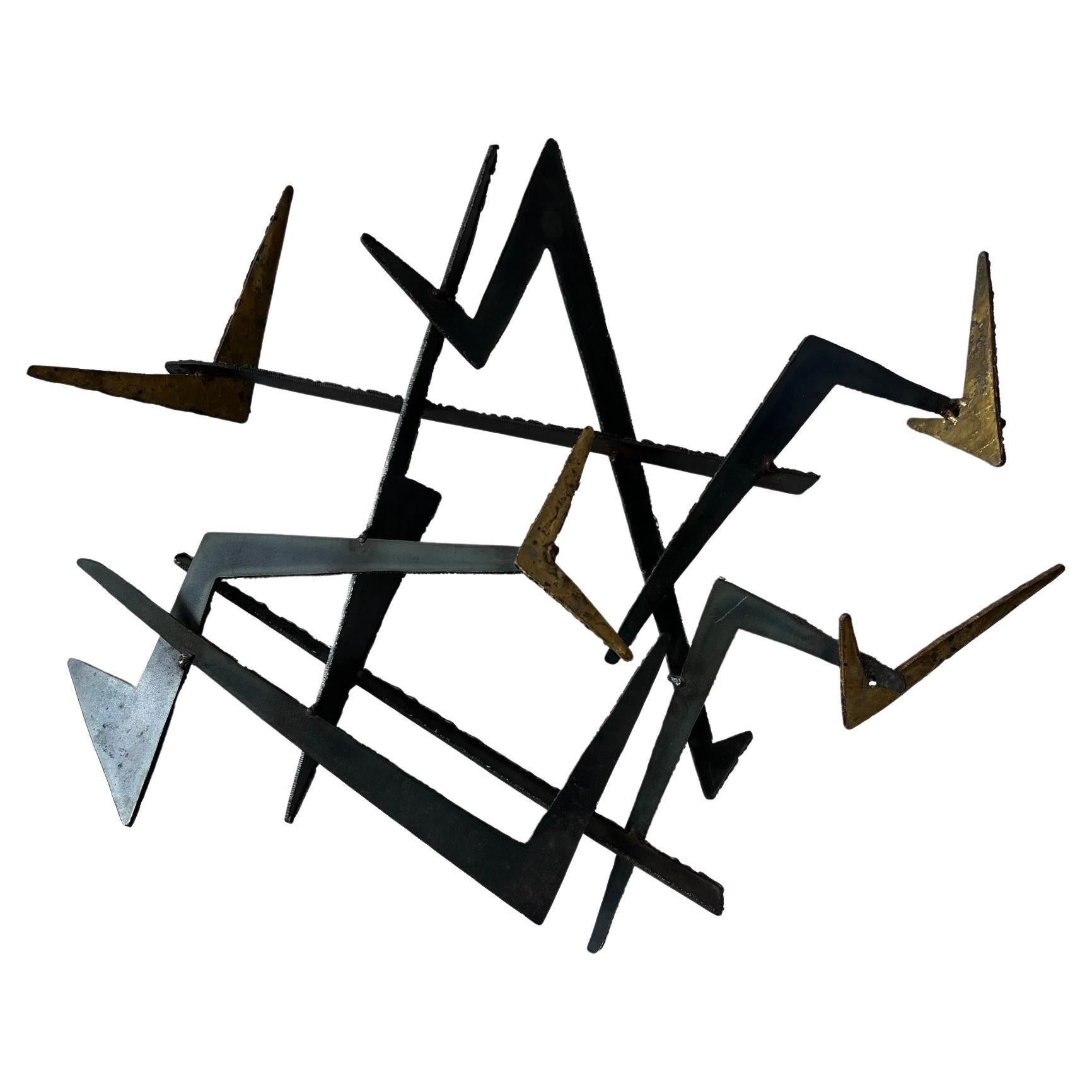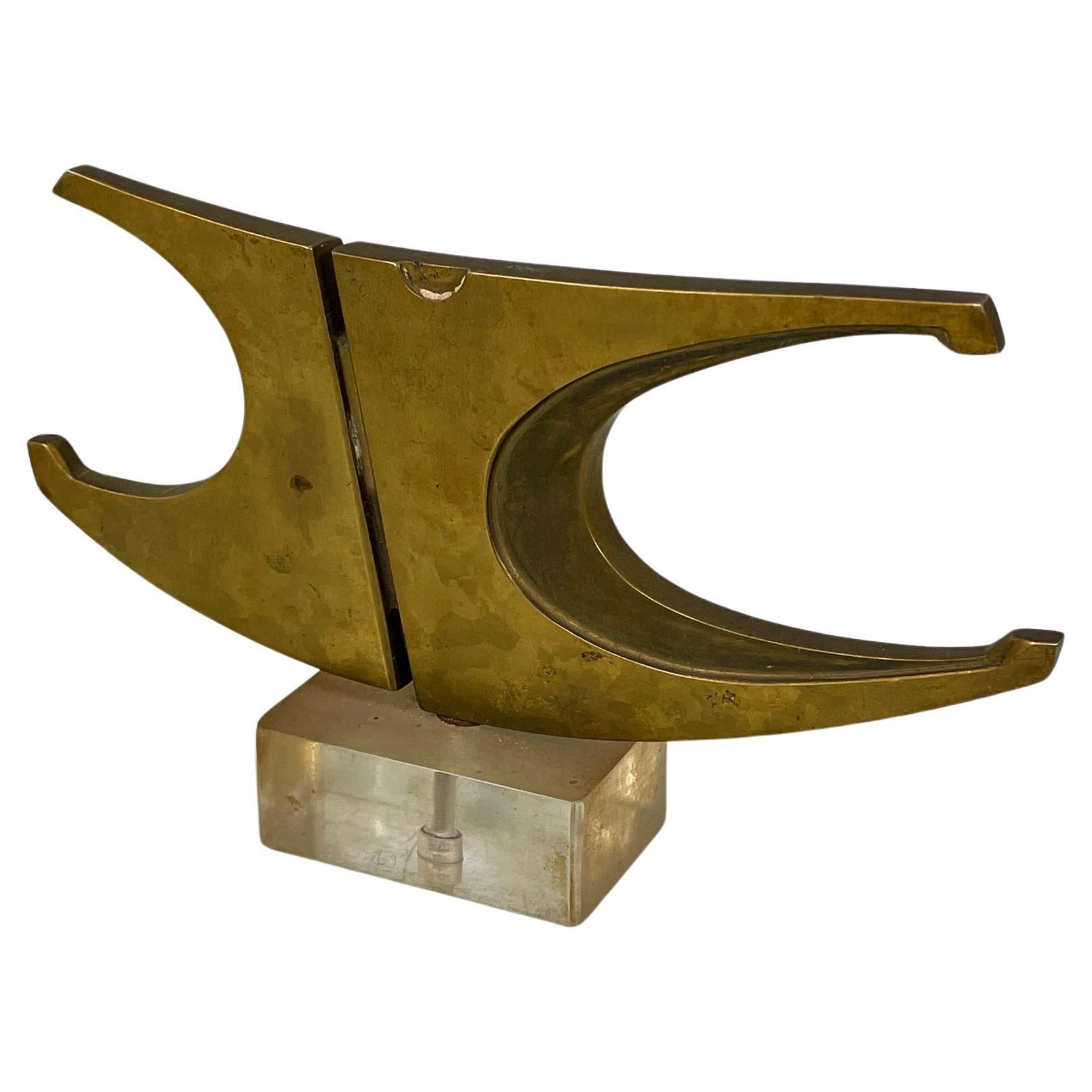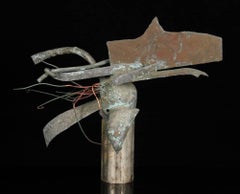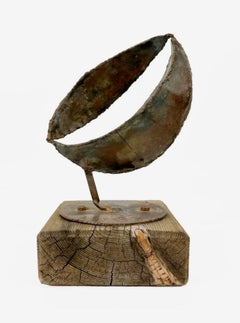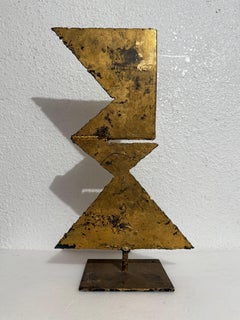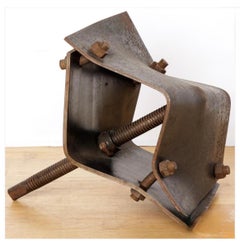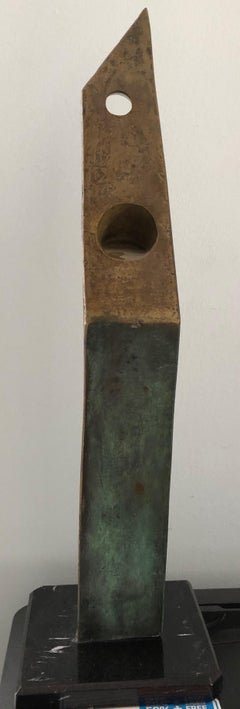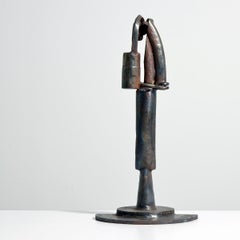Items Similar to Spanish Catalan Xavier Corbero Bronze Steel Architectural Abstract Sculpture
Want more images or videos?
Request additional images or videos from the seller
1 of 15
Xavier Corberó i OlivellaSpanish Catalan Xavier Corbero Bronze Steel Architectural Abstract Sculpture1963
1963
$2,200
£1,660.28
€1,900.77
CA$3,102.73
A$3,406.41
CHF 1,777.13
MX$41,222.30
NOK 22,273.58
SEK 20,987.57
DKK 14,188.73
About the Item
Xavier Corberó Olivella (1935 – 2017)
Estructuras Continual
Bronze sculpture. Comprised of four elements, independant, 1 spheric.
5 X 8 X 7 inches approximately. The pieces are kinetic and moveable so dimensions are a bit variable.
This is accompanied by a hand signed and dated photo certificate of the piece. A silver gelatin photograph. The photo is badly torn.
Xavier Corberó i Olivella (1935 – 2017) was a prominent Catalan artist, best known for monumental public sculpture and his palatial house complex in Esplugues de Llobregat near Barcelona. He has been described as "widely considered the most important Catalan artist since Antonio Gaudí," as "one of Spain’s most celebrated sculptors" and as having "perhaps influenced Barcelona more than any artist since Gaudí." Corberó's grandfather Pere Corberó i Casals (1875-1959) was an entrepreneur and artist whose works included the bronze memorial on the birthplace of Enrique Granados, also in Lleida. He was a cofounder of Barcelona's association for the promotion of decorative arts, a precursor to the Design Museum, now known as the Foment de les Arts i el Disseny. The Corberó foundry produced sculptures by prominent Catalan sculptors of the time such as Pablo Gargallo, Josep Viladomat and Frederic Marès. It was also an industrial and commercial business that sold bronze doors, chandeliers, fountains, and other decorative items, with a showroom in downtown Barcelona at Rambla de Catalunya 105, in a building designed by Arnau Calvet i Peyronill, and a workshop nearby at Carrer Aribau 103.
Pere's son and Corberó's father, Xavier Corberó i Trepat (1901-1981), also worked in the family bronze workshop. Together with his brother Valeri Corberó i Trepat, a noted interior designer and decorator, he was one of the co-founders of the Escola Massana art school in Barcelona. In 1950 he enrolled at Escola Massana, and in 1953 volunteered for military service in the Spanish Air Force. In 1955 he lived briefly in Paris and Stockholm, then until 1959 in London where he was the first-ever Spanish student at the Central School of Arts and Crafts. He then went on to work for a while in Lausanne, Switzerland. In Barcelona in the early 1960s he befriended Ricardo Bofill, Antonio Gades, Luis Marsans, and Manuel Viola. In 1962 he moved to New York City at Viola's suggestion. There he spent time with such prominent artists as Marcel Duchamp, Max Ernst and Man Ray, before moving back to Barcelona in the mid-1960s. In the ensuing years he immersed himself further in the artistic community of Barcelona and Cadaqués, developing a close friendship with Salvador Dalí (whom he described as his "first patron") as well as with Jorge Castillo, Robert Llimós, Josep Llorens i Artigas, Roberto Matta, Joan Miró, Elsa Peretti, Joan Ponç, and Josep Lluís Sert among others. By the early 1970s he was printing etchings on behalf of Joan Miro and producing jewelry for Peretti in his Esplugues workshop. Around that time he also met the British landscape architect Russell Page, of whom he viewed himself as a disciple. From the mid-1970s he again spent extended periods in New York, where his circle included Claes Oldenburg, Richard Serra, Donald Sultan, Bryan Hunt, Beverly Pepper, Vincent Desiderio, Kenneth Frampton, and Robert Hughes.
Corberó married actress Mary-Ann Bennett in 1958. Their daughter Ana Corberó was born in 1960. They separated in the early 1970s, at a time when Corberó was in a relationship with Italian model Elsa Peretti whom he had helped become a jewelry designer. In 1983 he married Maria Luisa Tiffón. In his later life he was in a relationship with Maria Dolors (Midu) Rica, whom he had known in 1973.
Xavier Corbero Olivella died in April 2017, aged 81, and was buried at Montjuïc Cemetery in Barcelona.
Work and recognition
Corberó had his first metal sculptures exhibited in 1955 at the third Hispano-American Biennial Exhibition. He participated in successive sessions of the avant-garde Saló de maig exhibition in Barcelona and won awards there in 1960 and 1961. He had his first individual exhibition in Munich in 1963, for which he received a Gold Medal from the State of Bavaria. Later solo exhibitions included shows at the Art Institute of Chicago (1964), Staempfli Gallery in New York (1966, 1975, 1980), Meadows Museum in Dallas (1980), and McNay Art Museum in San Antonio (1985).
Corberó's monumental sculptures can be seen in many places of Catalonia that include Barcelona, Esplugues de Llobregat, El Prat de Llobregat, Sabadell, Terrassa, Cassà de la Selva. Others are in Palma de Mallorca, Santa Cruz de Tenerife, London, Beirut, Dubai, Chicago, as well as in numerous museums such as the Meadows Museum in Dallas, the Nassau County Museum of Art, the Stedelijk Museum Amsterdam, the Victoria and Albert Museum, and the Metropolitan Museum of Art.
While sculpture was Corberó's dominant medium, together with architecture for his house, he also produced whimsical drawings, abstract paintings, and poems in Catalan.
Following the return of democracy in Spain and the corresponding blossoming of cultural activity in Barcelona, culminating in the 1992 Summer Olympics, and jointly with New York art dealer Joseph A. Helman, Corberó successfully encouraged his prominent artist friends to donate monumental sculptures as a participation to the city's renewal, at almost no cost to the city other than that of the sculptures' materials. That initiative brought Roy Lichtenstein's "El Cap de Barcelona" on the Port Vell waterfront, Claes Oldenburg's "Matches" in Vall d'Hebron, Richard Serra's "Wall" on Plaça de la Palmera, Beverly Pepper's "Cielo caído" and "Espiral arbolada" in the Parc de l'Estació del Nord, Bryan Hunt's "Rites of Spring" in the Parc del Clot, and Anthony Caro 's "Alto Rhapsody" in the Parc de l'Espanya Industrial. He was also the designer of the 1992 Olympic medals, for which on his insistence real gold was used for the first time.
In 1992 he received the Creu de Sant Jordi Award from the Generalitat de Catalunya, in recognition of his role in Barcelona's public sculpture program. In 2000 he became a member of the Reial Acadèmia Catalana de Belles Arts de Sant Jordi.
In 1968, Corberó started acquiring land, including a former potato farm, bordering Montserrat Street in the Barcelona suburb of Esplugues de Llobregat, not far from where his parents lived. He developed it into a highly elaborate complex of spaces, known as of 2022 as "Corberó's space" (Catalan: Espai Corberó). While Corberó was alive, the property was partly devoted to hosting artists-in-residence as well as his own home. The sprawling compound includes a significant share of his life's work and personal collections, and he kept building it up until his death.
The Espai Corberó ensemble includes two historic houses, Can Cargol and Can Bialet, the former of which he restored in 1970-1971 with the help of architect and builder Emilio Bofill, who was also involved in the early stages of construction of the main complex across Montserrat Street. Corberó's visually striking house has been featured as background stage in multiple occasions, including Woody Allen's film Vicky Cristina Barcelona in 2008 and The New Yorker's "Goings on About Town" section in 2020. Lluís Lleó, an artist and acquaintance of Corberó, described it as "a self-portrait".
In July 2022, it was reported that Corberó's heirs would sell the complex to the municipality of Esplugues for development as a cultural property. It opened to visitors on 18 May 2024, on the occasion of International Museum Day.
His work was included in the collection of the Bundy Modern. Built in 1962 as an art and sculpture gallery, the Bundy was designed in the Bauhaus style by Harvard GSD architect, Harlow Carpenter in 1962. The venue's first decade was lively with exhibitions that featured a large cast of artists, including Dino Basaldella, Judith Brown, Silvana Cenci, Xavier Corbero, Ivanhoe Fortier and Louise Nevelson. In a catalog for one such show, in 1963, Carpenter wrote that he envisioned the Bundy Center for the Arts (as he called it then) as "a country museum where space would be an inherent commodity and painting and sculpture could be viewed leisurely against a Vermont landscape."
- Creator:Xavier Corberó i Olivella (Spanish)
- Creation Year:1963
- Dimensions:Height: 5 in (12.7 cm)Width: 8 in (20.32 cm)Depth: 7 in (17.78 cm)
- Medium:
- Movement & Style:
- Period:
- Condition:please see all photos minor casting imperfections as produced. photo certificate has significant wear.
- Gallery Location:Surfside, FL
- Reference Number:1stDibs: LU38216740642
About the Seller
4.9
Platinum Seller
Premium sellers with a 4.7+ rating and 24-hour response times
Established in 1995
1stDibs seller since 2014
1,810 sales on 1stDibs
Typical response time: 1 hour
- ShippingRetrieving quote...Shipping from: Miami, FL
- Return Policy
Authenticity Guarantee
In the unlikely event there’s an issue with an item’s authenticity, contact us within 1 year for a full refund. DetailsMoney-Back Guarantee
If your item is not as described, is damaged in transit, or does not arrive, contact us within 7 days for a full refund. Details24-Hour Cancellation
You have a 24-hour grace period in which to reconsider your purchase, with no questions asked.Vetted Professional Sellers
Our world-class sellers must adhere to strict standards for service and quality, maintaining the integrity of our listings.Price-Match Guarantee
If you find that a seller listed the same item for a lower price elsewhere, we’ll match it.Trusted Global Delivery
Our best-in-class carrier network provides specialized shipping options worldwide, including custom delivery.More From This Seller
View AllBrutalist Bronze Abstract Modernist Sculpture
Located in Surfside, FL
In the manner of Julio Gonzalez, mixed metal sculpture.
Neo-Dada Abstract Sculpture: Assemblages
Abstract sculpture followed a slightly different course. Rather than focusing on non-figurative subject matter, it concentrated on materials, hence the emergence of Assemblage Art - a form of three-dimensional visual art made from everyday objects, said to be 'found' by the artist (objets trouves). Popular in the 1950s and 1960s in America, assemblage effectively bridged the gap between collage and sculpture, while its use of non-art materials - a feature of Neo-Dada art - anticipated the use of mass-produced objects in Pop-Art. Assemblage sculpture is exemplified by the works of Louise Nevelson (1899-1988), such as Mirror Image 1 (1969, Museum of Fine Arts, Houston), and by Jean Dubuffet (1901-85) and his Monument with Standing Beast (1960, James R. Thompson Center, Chicago). The idiom was considerably boosted by an important exhibition - "The Art of Assemblage" - at the Museum of Modern Art, in New York, in 1961.
Other examples of the Neo-Dadaist-style "junk art...
Category
20th Century Abstract Expressionist Abstract Sculptures
Materials
Bronze, Copper
1965 Canadian Israeli Art Brutalist Abstract Welded Steel Sculpture Eli Ilan
Located in Surfside, FL
Eli Ilan (אלי אילן), 1928-1982 was an Israeli sculptor.
Abstract organic pod shape. in either steel or iron mounted on a wooden plinth.
Ilan was born in Winnipeg, Manitoba. He enrolled in a premedical curriculum at the University of British Columbia in Vancouver and emigrated to Israel in 1948. He then studied prehistoric archaeology and physical anthropology at the Hebrew University of Jerusalem. In 1956, he returned to Canada to study sculpture at the Ontario College of Art & Design. He lived in Kibbutz Sasa from 1959 to 1963. He died in 1982 in Caesarea, Israel.
Education
1955 Hebrew University, Jerusalem, pre-historic archaeology and physical anthropology
1956 Ontario College of Art, Toronto, Canada, sculpture under Thomas Bowie
1959 Training College, Ottawa, criminal identification techniques
1969 Art Festival, Painting & Sculpture in Israel. Ganei Hataarucha, Tel Aviv
Artists: Chana Orloff, Eli Ilan, Zvi Aldouby, Jacob El Hanani, Ludwig Blum, Aharon Bezalel, Koki Doktori, Israel Hadany, Marcel Janco, Dov Feigin, Abel Pann, Esther Peretz Arad, Reuven Rubin, Ivan Schwebel, Jakob Steinhardt, Boris Schatz, Bezalel (Lilik) Schatz, Louise Schatz...
Category
1960s Abstract Abstract Sculptures
Materials
Stainless Steel
Mexican Art Abstract Brutalist Gilt Steel Geometric Sculpture Mathias Goeritz
By Mathias Goeritz
Located in Surfside, FL
Mathias Goeritz (German Mexican, 1915-1990)
Geometric Torch-cut Steel or Iron Sculpture with gold leaf gilding. Welded signature, MG. This came from an estate and is signed with his ...
Category
20th Century Modern Abstract Sculptures
Materials
Iron, Gold Leaf, Steel
Corten Steel Sculpture Oleg Sohanievich Non Conformist Avant Garde Ukrainian
Located in Surfside, FL
Oleg Sohanievich (Soviet Ukrainian, American 1935-2017)
Steel Stress Sculpture #3, 1982,
Hand signed and dated Oleg Sohanievich '82
Dimensions: 17" h., 23" w., 16" d.
Very heavy
Th...
Category
1980s Post-Modern Abstract Sculptures
Materials
Steel
Scottish Abstract Contemporary Minimalist Art Bronze Sculpture Alan Johnston 2/2
Located in Surfside, FL
Alan Johnston (Scottish, born 1945),
Untitled, 1988, cast bronze, edition of 2, cast #2
Incised A.J. 2/2 88 on underside
Provenance: Jack Tilton Galler...
Category
1980s Abstract Sculptures
Materials
Bronze
Corten Steel Sculpture Oleg Sohanievich Non Conformist Avant Garde Ukrainian
Located in Surfside, FL
Oleg Sohanievich (Soviet Ukrainian, American 1935-2017)
Cor-ten steel Stress Sculpture #5,
1976
Hand signed and dated Oleg Sohanievich '76
Dimensions 9" h., 13" w., 27" d.
Very he...
Category
1970s Post-Modern Abstract Sculptures
Materials
Steel
You May Also Like
American Artist, Abstract Sculpture, Metal, USA, 1960s
Located in High Point, NC
An abstract cast metal sculpture, produced in the US, c. 1960s.
Category
Vintage 1960s American Modern Abstract Sculptures
Materials
Metal
Enrique "Sebastian" Carbajal Modernism Bronze Sculpture
By Enrique Sebastian Carbajal
Located in San Francisco, CA
Enrique "Sebastian" Carbajal (Born 1947) bronze sculpture
Brilliant bronze sculpture by listed Mexican artist Enrique "Sebastian" Carbajal.
This Mexican modernist bronze sculpture sits atop a marble base.
Signed in the bronze.
The base measures: 4.5" wide x 3" deep. The sculpture stands 24" tall.
Sebastián (born Enrique Carbajal González...
Category
Late 20th Century Abstract Abstract Sculptures
Materials
Bronze
Seule Italy 1985 Post-Modern Bronze Abstract Sculpture by Annie Lambert
Located in Brescia, IT
This is an interesting and deep multiple artwork by Annie Lambert, a talented artist of 1980’ in Italy.
This is a multiple of a numbered edition of 1.00...
Category
1980s Abstract Abstract Sculptures
Materials
Bronze
Karl Stirner Abstract Brutalist Bronze Sculpture, 19.75"H
Located in Lake Worth Beach, FL
Artist/Designer; Manufacturer: Karl Stirner (German/American, 1923-2016)
Marking(s); notes: signed
Materials: bronze
Dimensions (H, W, D): 19.75"h, 10"w, ...
Category
20th Century Abstract Abstract Sculptures
Materials
Bronze
Unusual Brutalist Steel Sculpture
By David Smith
Located in St.Petersburg, FL
An unusual steel-torch cut and welded sculpture. Brutalist and jazzy. Unsigned. Heavy thick steel with patina and some areas gilded.
Category
Vintage 1960s American Mid-Century Modern Abstract Sculptures
Materials
Cut Steel
Italian modern Brutalist style Bronze sculpture by Edmondo Cirillo, 1970s
Located in MIlano, IT
Italian modern Brutalist style Bronze sculpture by Edmondo Cirillo, 1972
Bronze sculpture with reference to the brutalist style. The shape alternates round parts with more square pa...
Category
Vintage 1970s Italian Modern Abstract Sculptures
Materials
Bronze
